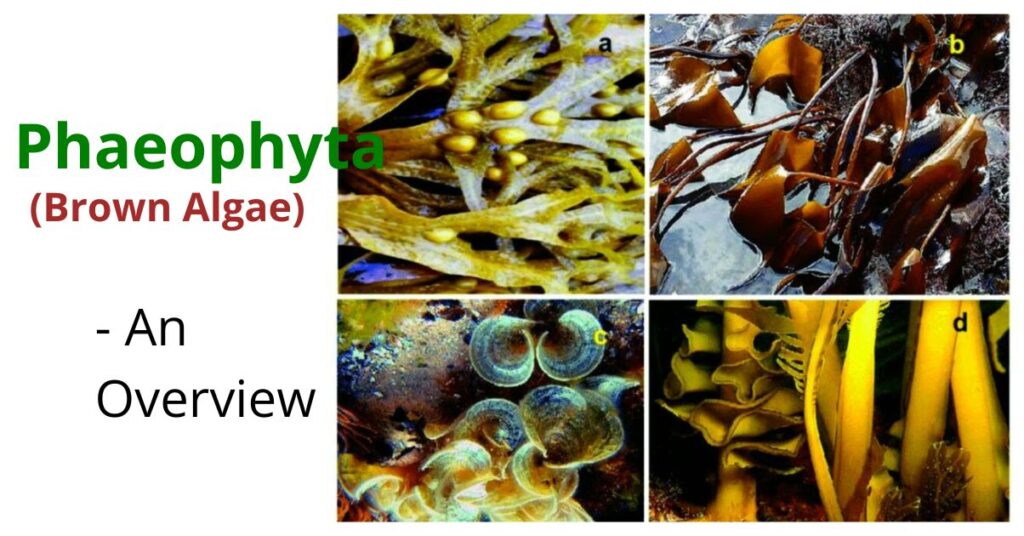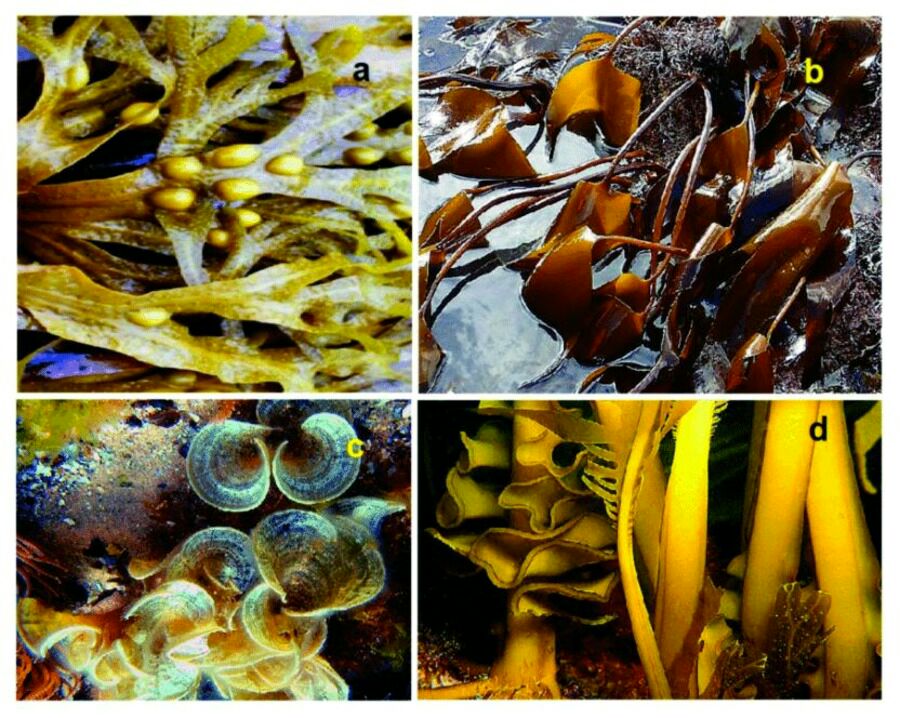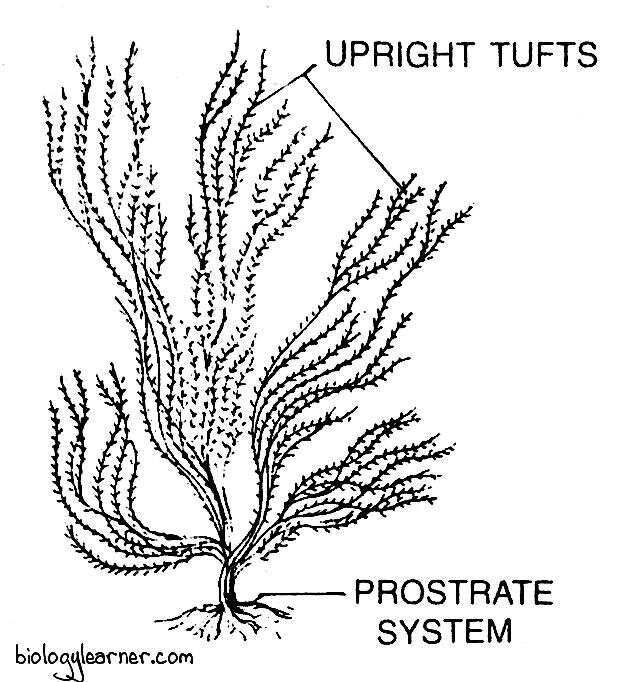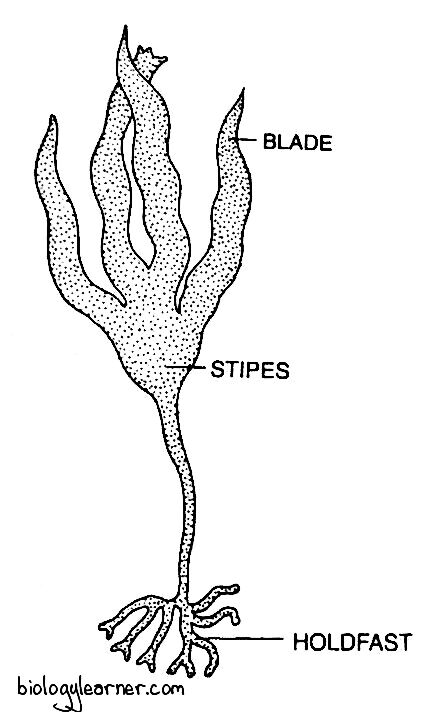The members of the Phaeophyta (class Phaeophyceae) are known as brown algae due to their characteristic brown colour. They exhibit a brown colour because of the presence of the golden brown pigment fucoxanthin.
The plant body of brown algae is multicellular and structurally complex.
Characteristics of Phaeophyta
- Most of the brown algae are marine. They are extremely rare in freshwater habitats.
- The plant body is always multicellular and highly differentiated, both externally and internally.
- The structure of the thalli varies greatly, from a simple microscopic heterotrichous filament (e.g., Ectocarpus) to complex foliage plants (e.g., Macrocystis pyrifera).
- The plant body is generally differentiated into a holdfast, stipe, and blade.
- The cell wall is thick and bi-layered. The outer gelatinous layer is composed of alginic and fucinic acids, while the inner layer consists mainly of cellulose.
- Many small vesicles and some whitish granules called fucosan vesicles are usually present in the cells.
- Photosynthetic pigments such as chlorophyll-a, chlorophyll-c, β-carotene, flavoxanthin, violaxanthin, and fucoxanthin are found in chromatophores. The chlorophyll is masked by fucoxanthin, which gives this group its characteristic brown colour.
- Pyrenoid is generally absent, but if present, it is stalked or at least protrudes from the chloroplast.
- Growth may be apical (Fucus), intercalary (Laminaria), or trichothallic (Ectocarpus).
- Mannitol and laminarin are the common reserve food materials.
- Motile cells, i.e., reproductive structures (zoospores or gametes), have two laterally inserted unequal flagella, of which the larger one is the tinsel type.
- Asexual reproduction occurs through zoospores. The zoospores may be haploid (produced in unilocular sporangia) or diploid (formed within the plurilocular sporangia). However, in Fucales and Dictyotales, asexual reproduction is not seen.
- Sexual reproduction takes place by isogamy (Ectocarpales), anisogamy (Tilopteridales), and oogamy (Fucales and Laminariales).
- The zygote does not undergo meiotic division, and on germination, it gives rise to a diploid sporophytic plant body.
- The alternation of generations is very distinct in Phaeophyta. Most of the members show isomorphic (Ectocarpus) or heteromorphic (Laminaria) alternations of generation.

Distribution of Phaeophyta
The division Phaeophyta contains about 265 genera and 1500–2000 species.
Most brown algae are marine (99.7%). Some members, such as Sphacelaria, Pleurocladia, Heribaudiella, and Bodanella, are found in freshwater. Pleurocladia locustris occur in both freshwater and marine habitats.
In North Atlantic and North Pacific, large brown algae sometimes grow in great abundance, both in the intertidal zone.
The majority of the marine brown algae grow attached to rocks or other solid substrates, while a few species occur in association with other algae, either as epiphytes or endophytes.

Thallus Organization of Phaeophyta
Phaeophyta is having the most developed form of thallus. They show great variation in the vegetative structure.
The thalli ranges from a simple microscopic heterotrichous filament to a more elaborate macroscopic parenchymatous organization. In Ectocarpus, the thallus is divided into erect and prostrate systems. Heterotrichy is found only during the young stage.

The thallus is condensed and multicellular in large species, where differentiation of tissue is also seen like that of vascular plants. Such algae are known as kelps or rockweeds.
Macrocystis pyrifera is the largest algae, attaining a length of 60 metres or so. It is also known as giant kelp. The bladder kelp, Nereocystis luetkeana, is about 25–30 metres long. Lessonia flavicans looks like a miniature tree and reaches a length of 4 metres.
In Postelsia palmaeformis, one thick bulb is found in which many blades are present. It appears like a palm tree and is commonly known as the sea palm or palm seaweed. Laminaria is known to have a holdfast, stipe, and blade in its thallus.

The thallus of Ectocarpus consists of rows of similar cells, while Fucus and Laminaria are internally differentiated into the epidermis, cortex, and medulla. The epidermis provides protection, the cortex stores food materials, and the medulla is helpful in transportation.
Cell Structure of Phaeophyta
The phaeophyta cell has the following main components:
- Cell Wall: The cell wall is differentiated into two layers. The outer slimy layer has alginic acid and fucoidan, while the inner layer is made up mainly of cellulose.
- Cell Membrane: Below the cell wall, a thin cell membrane is present, which encloses the protoplast.
- Nucleus: The protoplast contains a single nucleus with one or two nucleoli. A nuclear membrane is present over the nucleus.
- Vesicles: Each cell possesses many small vesicles and white granules in the cytoplasm. The granules are called fucosan vesicles.
- Chloroplast and Reserved Food: Chromatophores are flat, partial, or discoid, in which chlorophyll-a, chlorophyll-c, β-carotene, fucoxanthin, flavoxanthin, lutein, and violaxanthin are found. Pyrenoids are usually absent. Laminarin and mannitol are the reserved food materials present in the cytoplasm.
Reproduction in Phaeophyta
Members of Phaeophyta reproduce vegetatively, asexually, and sexually.
Vegetative Reproduction
Vegetative reproduction in brown algae usually occurs by fragmentation.
In Sargassum, special reproductive organs are developed called propagules. After being separated from the parent plant, each propagula can give rise to a new individual.
Asexual Reproduction
Asexual reproduction takes place through the formation of zoospores in all members of brown algae except Tilopteridales, Dictyotales, and Fucales.
Zoospores are produced in unilocular and plurilocular sporangia. In unilocular sporangia, the zoospores are haploid (n), while in plurilocular sporangia, they are diploid (2n).
Each zoospore is biflagellate. The two flagella are inserted laterally and are of unequal length, of which the longer one is tinsel type and the shorter one is whiplash type.
In Dictyota, the sporophyte bears unilocular tetrasporangia. These unilocular sporangia produce non-flagellated, thick-walled tetraspores or aplanospores.
Sexual Reproduction
In Phaeophyta, sexual reproduction is of the isogamous, anisogamous, and oogamamous types.
Generally, gametes are produced in plurilocular gametangia. The gametes may be equal in size (isogamy), or the female gametes may be larger than the male ones (anisogamy).
In oogamy, the male gametes are formed in the antheridium (male sex organ) and are called antherozoids, while the female gamete, known as an egg or ovum, is developed in the oogoium (female sex organ).
Antherozoids are small, active, motile, and produced in large numbers. But the egg is large and non-motile.
During fertilization, male and female gametes fuse together and form a diploid zygote.
Isogamy is seen among the members of Ectocarpales and Sphacelariales. Anisogamy is found in Cutleriales and Tilopteridales. In Fucales, Laminariales, and Dictyotales, sexual reproduction is of the oogamous type.
Alternation of Generations in Phaeophyta
In this group of algae, the alternation of generations is very clear.
Most of the members show either an isomorphic (both gametophyte and sporophyte are morphologically alike) or heteromorphic (both generations are morphologically dissimilar) alternation of generations.
In Laminariales, the gametophytes are microscopic and filamentous, while the sporphytes are very large. The multicellular diploid sporophytic phase alternates with the unicellular haploid gametophytic phase in Fucales.
The members of Phaeophyta show the following different types of life cycles:
- Diplontic life cycle, e.g., Sargassum
- Diplohaplontic life cycle
- Isomorphic type, e.g., Ectocarpus
- Heteromorphic type, e.g., Laminaria
Classification of Phaeophyta
The division Phaeophyta contains the only class Phaeophyceae. Fritsch (1935) classified the class Phaeophyceae into nine orders.
The outline of the classification is given below:
- Order 1. Ectocarpales (e.g., Ectocarpus)
- Order 2. Tilopteridales (e.g., Tilopteris)
- Order 3. Cutleriales (e.g., Cutleria)
- Order 4. Sporochnales (e.g., Sporochnus)
- Order 5. Desmarestiales (e.g., Desmarestia)
- Order 6. Laminariales (e.g., Laminaria)
- Order 7. Sphacelariales (e.g., Sphacelaria)
- Order 8. Dictyotales (e.g., Dictyota)
- Order 9. Fucales (e.g., Fucus)

I found it very interesting